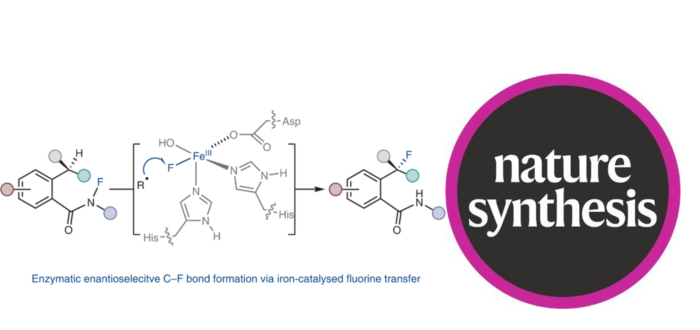In recent years there has been a surge in the development of methods for the synthesis of organofluorine compounds. However, enzymatic methods for C–F bond formation have been limited to nucleophilic fluoride substitution. In a new work led by Prof. Xiongyi Huang (Johns Hopkins University, USA) and in collaboration with the group of Dr. Marc Garcia-Borràs (IQCC), they report the incorporation of iron-catalysed radical fluorine transfer, a reaction mechanism that is not used in naturally occurring enzymes, into enzymatic catalysis for the development of biocatalytic enantioselective C(sp3)–F bond formation. Using this strategy, the authors repurposed (S)-2-hydroxypropylphosphonate epoxidase from Streptomyces viridochromogenes (SvHppE) to catalyse an N-fluoroamide-directed C(sp3)–H fluorination. Directed evolution guided by mechanistic understanding and computational modeling has enabled SvHppE to be optimized, forming diverse chiral benzylic fluoride products with turnover numbers of up to 180 and with excellent enantiocontrol (up to 94% enantiomeric excess). Mechanistic investigations showed that the N–F bond activation is the rate-determining step, and the strong preference for fluorination in the presence of excess NaN3 can be attributed to the spatial proximity of the carbon-centred radical to the iron-bound fluoride, as suggested by the computational models.
Dr. Jordi Soler (Garcia-Borràs’ group) is the co-first author of this publication recently reported in the Nature Synthesis journal (Nat. Synth (2024). https://doi.org/10.1038/s44160-024-00507-7). Dr. Garcia-Borràs is co-corresponding author of the study, which has been led by Prof. Xiongyi Huang from John Hopkins University. This work builds upon previous collaborative efforts, where the authors successfully incorporated a new radical-relay C(sp3)-H azidation reaction into a non-heme iron enzyme. This significant advancement was published in Science (2022, 376, 869-874, DOI: 10.1126/science.abj2830).
This project is a core part of the research program that Dr. Garcia-Borràs leads at the IQCC, which is devoted to the use of computational methods in combination with experiments to characterize and design new abiological enzymatic activities and synthetically useful biocatalysts: “Biocatalytic intermediates for the discovery and design of new enzymatic activities“.
It has been recently published open access in Nature Synthesis:
Q. Zhao‡, Z. Chen‡, J. Soler‡, X. Chen, J. Rui, N. T. Ji, Q. E. Yu, Y. Yang*, M. Garcia-Borràs*, X. Huang*(‡: These authors have equally contributed)
“Engineering non-haem iron enzymes for enantioselective C(sp3)–F bond formation via radical fluorine transfer”
Nat. Synth., 2024, ASAP.
DOI: 10.1038/s44160-024-00507-7
Girona, May 10th, 2024
For more info: ges.iqcc@udg.edu

